Important Questions for Class 12 Biology Chapter 12 – Ecosystem Very Short Question And Answers
Question 1. In the illustration given below of a simplified food web on an island, the arrows indicate the direction of energy How and the Roman numbers indicate species within the food web?
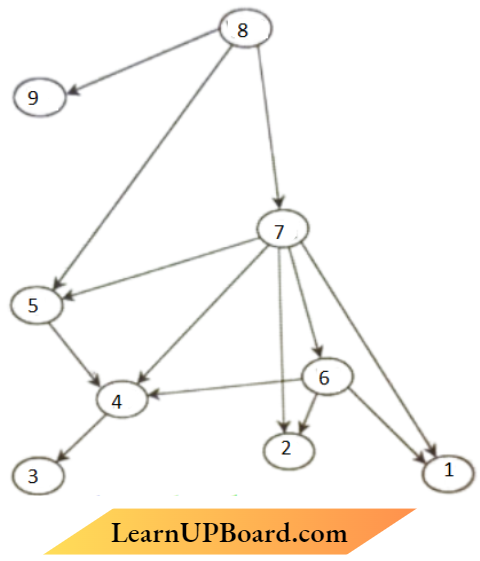
ecosystems questions and answers
At which trophic level or levels does species VIII function?
- 2″d and 3″J consumer
- P consumer
- Producer
- 3, a and 4’1′ consumer
Answer: 3. Produce
Important Questions for Class 12 Biology Chapter 12 – Ecosystem Short Question And Answers
Question 1. Explain reasons why the pyramid of energy is always upright.
Answer:
- The pyramid of energy is always upright because in an ecosystem the energy flow is always unidirectional, when energy flows from a trophic level to the next level, some energy is always lost to the atmosphere in the form of heat& never goes back to the sun
- There is a gradual decrease in energy at successive trophic levels, this happens according to the 10% law of energy transfer, where only 10% of total energy is transferred from one to the next level, the energy is highest at the producer level and it gradually decreases on moving from producer to top carnivore.
“questions about ecosystem with answers “
Read and Learn More Important Questions for Class 12 Biology Chapter Wise
Question 2. Describe the inter-relationship between productivity, gross primary productivity, and net productivity.
Answer:
- Productivity is the rate of biomass production per unit area over some time.
- Gross primary productivity is the rate of production of organic matter during photosynthesis in an ecosystem and Net productivity is the gross primary productivity minus respiration losses (R).
GPP – R = NPP
Important Questions for Class 12 Biology Chapter 12 – Ecosystem Long Question And Answers
Question 1.
1. Construct a pyramid of biomass of the grassland ecosystem. How is the pyramid of biomass in the sea different from it?
Answer: Pyramids of biomass in grassland ecosystem – upright, Pyramid of biomass in the sea – (generally)inverted.
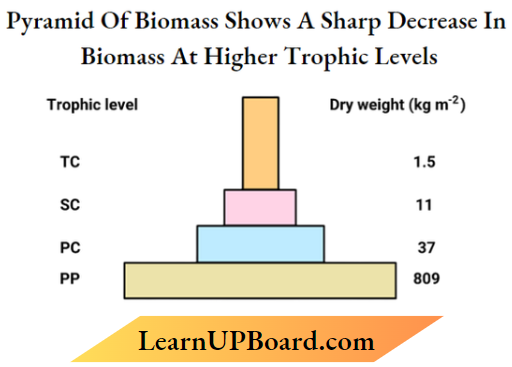
“ecosystem question answer “
2. Name the primary producer and primary consumer in the sea.
Answer:
- Primary producers – phytoplankton.
- Primary consumers – fishes or zooplankton.
3. What is a standing crop?
Answer: Each trophic level has a certain mass of living material at a particular time called the standing crop.
Question 2.
1. What does an ecological pyramid represent? State any two limitations that these pyramids have.
Answer:
- Ecological pyramids represent the relationship between different trophic levels in terms of number, biomass, or energy Limitations of the pyramid:
- It does not take into account the same species belonging to two or more trophic levels. It assumes a single food chain which rarely exists in nature.
- It does not accommodate a food web or Saprophytes are not given any place even though they play a vital role in the ecosystem.
“ecosystem questions “
Question 2. Describe an inverted pyramid of biomass with the help of an example.
Answer: The pyramids of biomass in aquatic ecosystems or sea are generally inverted example biomass of fish is much more than the biomass of phytoplanktons.
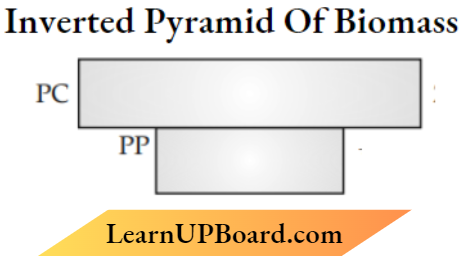
Question 3.
1. What is a trophic level in an ecosystem? What is a ‘standing crop’ concerning it?
Answer: The specific place of an organism in a food chain, the mass of living material (biomass) at each trophic level at a particular time.
2. Explain the role of the ‘first trophic level’ in an ecosystem.
Answer: The first trophic level has producers or autotrophs. which traps solar energy to produce food (photosynthesis).
3. How is the detritus food chain connected with the grazing food chain in a natural ecosystem?
Answer:
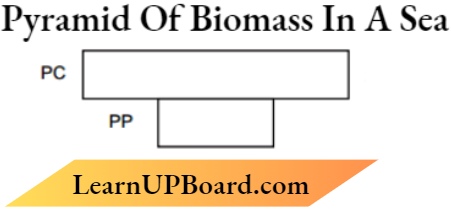
“questions for ecology “
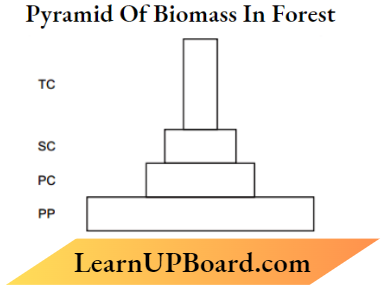
Organisms of the Detritus food chain (DFC) are the prey to the Grazing food chain (GFC) organism, the dead remains of GFC are decomposed into simple inorganic materials which are absorbed by DFC organisms.
Question 4. Draw the pyramids of biomass in the sea and a forest. Explain giving reasons why are the two pyramids different.
Answer:
- Sea – Inverted. because the biomass of fish or other aquatic animals exceeds that of phytoplankton or a small standing crop of phytoplankton supports a large standing crop of zooplankton.
- Forest – Upright. because the biomass of producers exceeds that of herbivores or carnivores or allows a sharp decrease in biomass at higher trophic levels.
Question 5.
1. What is an ecological pyramid? Compare the pyramids of energy, biomass, and numbers.
Answer:
Graphical representation of the relationship among the organisms at different trophic levels
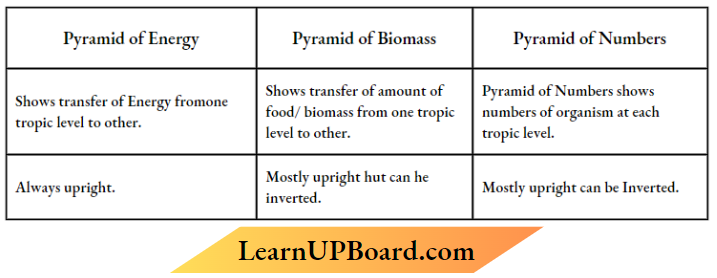
“ecosystem bank of biology “
2. Write any two limitations of ecological pyramids.
Answer: It does not accommodate the food web and does not take into account the same species belonging to two or more tropic levels. Saprophytes are not given any place.
Question 6.
1. Comment on the pattern in which all communities undergo a change in composition and structure with changing environmental conditions.
Answer:
- All communities are that their composition and structure constantly change in response to the changing environmental conditions.
- This change is orderly and sequential, parallel with the changes in the physical environment.
- These changes lead finally to a community that is in near equilibrium with the environmental aid that is called a climax community.
- The gradual and fairly predictable change in the species composition of a given area is called ecological succession.
- During succession, some species colonize an area and their population becomes more numerous whereas populations of other species decline and even disappear.
2. Explain ‘Climax community’ and ‘sere’.
Answer:
- A community that is in near equilibrium with the environment is called a climax community.
- The entire sequence of communities that successively change in a given area is called sere(s).
“class 12 bio ecosystem notes “
3. Differentiate between primary and secondary succession with examples.
Answer:
- In primary succession in water, the pioneers are the small phytoplanktons, which are replaced with time by rooted-submerged plants, rooted-floating angiosperms followed by free-floating plants, then reed-swamp, marsh-meadow, scrub, and finally the trees.
- The climax again would be a forest. With time the water body is converted into land.
- In secondary succession the species that invade depend on the condition of the soil, availability of water, the environment as also the seeds or other propagates present.
- Since soil is already there, the rate of succession is much faster, and hence, climax is also reached more quickly.
